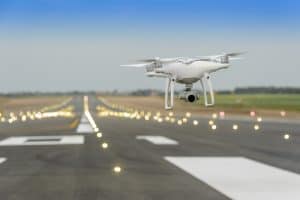
Airports are investing more and more into new technologies that enhance and improve the passenger journey, and for good reason. Not only do these new technologies increase efficiency, but passengers also have now come to expect these types of tech, from the Internet of Things (IoT) to biometrics to drones, as part of their daily lives.
We work closely with airports, operators and airlines, helping them understand and implement different approaches, whether it is introducing new autonomous technologies or scientific approaches to data analytics so they can innovate their future airports.
Take a look at our two-part blog to see what new technology can be expected over the next few years.
Robotic Baggage Build
By using robotics and artificial intelligence in the baggage handling system, bags can be collected, checked in, transported and loaded onto the correct flight without ever having to enter the terminal building or be directly handled by anyone other than the passengers themselves.
This obviously improves bag connection & occupational health for the handlers, as well as meaning fewer bags and trolleys entering the terminal, therefore reducing congestion within the airport, reducing queues and increasing passenger experience.
AiQ already has experience with robotics, having worked with Heathrow on the five automated baggage cells in Terminal 3. Two of these five cells are robotic. We have programmed specialist demand and capacity planning tools as well as analysing and predicting demand on individual ULDs on a flight and segregation (1st class, premium, economy, transfers) basis.
Biometric Security
Biometrics are increasingly present in daily life, including voice, fingerprint and facial recognition on our smart phones, so they are inevitably going to have an impact on future airports. These developments in biometrics can have a positive effect, allowing trusted passengers ‘bypass’ intrusive security devices, reducing Landside queues.
Biometrics may well replace all forms of travel documentation, with facial, voice and other biometric scanning at every airport checkpoint. Sita has been trialing various biometric systems around the world, developing an all-biometric airport between check-in, bag drop, immigration and border control, airside security and the boarding gate. Once passengers are matched, they proceed through all of the terminal checkpoints from kerb to cabin without ever having to exhibit travel documents. Sita says that 57% of passengers say they’d prefer biometrics to passports and boarding passes
In Heathrow, British Airways announced this April that the first three biometric boarding gates for UK domestic flights departing from Heathrow Terminal 5 had been opened, enabling passengers to scan their own boarding pass at the gate and then walk through to the aircraft. A digital facial scan of the customer is recorded when they pass through security and when they arrive at the gate their face is matched, allowing them to board.
Autonomous Electric Vehicles
Autonomous Electric Vehicles, which include drones, could be replacing ground vehicles for movement of passengers and baggage, from hotels and staging points directly to Terminal or Aircraft, further reducing Landside Queues. Heathrow Airport has already shown how successful this can be, using a pod system to link between the T5 Business Car Park and the terminal since 2011. It’s clear that, after further development, these driverless pods could be taken off the rails and offer a more bespoke service, increasing efficiencies and reducing queues.
AiQ have just been awarded a Heathrow-wide GSE study to improve future safety, environmental and performance of ramp equipment with the electrification and automation of HoS (Head of Stand). This is arguably the most comprehensive attempt in the world to create a totally electric fleet of GSE in an airport. This would save energy and reduce C02 emissions with cleaner airport transport.
Drones and VTOL (Vertical Take-off and Landing) vehicles offering on-demand deliveries and flights are also a possibility, although these come with a few more challenges to overcome, including regulation and air traffic management fears.
Remote Air Traffic Control (ATC) Towers
As technology advances, it is now possible to site a control tower away from the airport itself, which is much more cost efficient. As NATS states , the advent of super-fast fibre networks, high definition cameras and remote sensing technology is allowing for this revolution in airport air traffic management. Using only a camera mast, images and data can be transmitted to a separate control centre that could be hundreds or even thousands of miles away with the airfield view, creating a live panoramic image augmented with other operational data, from radar labels on individual aircraft, to the location of closed taxiways.
AiQ have been working with airports worldwide to create intelligent, smart airports for the future. These smart airports are not just a vision, but a reality. With rising demand from passengers, these new technologies provide cost efficiencies, reduce congestion and match the demands from tech-savvy customers. With a strong IT networks, stakeholder engagement and communication, there’s no reason why any airport can’t benefit from these innovations.

